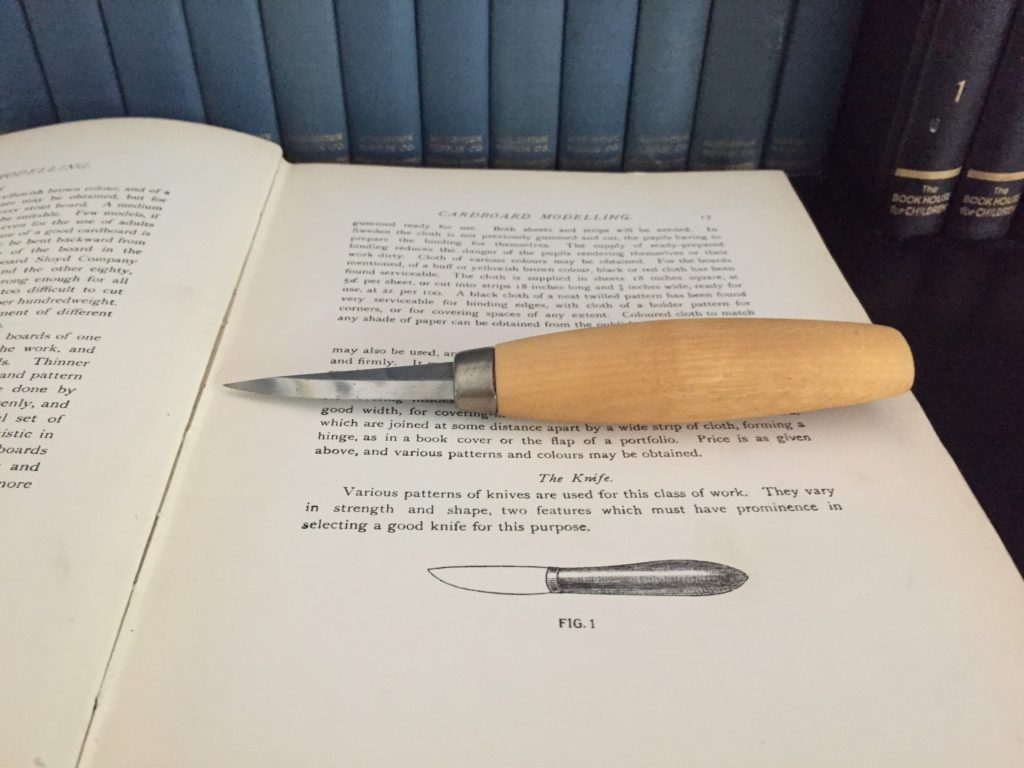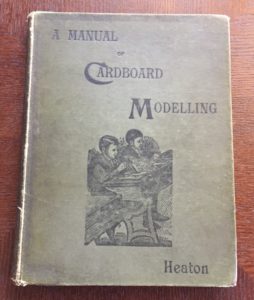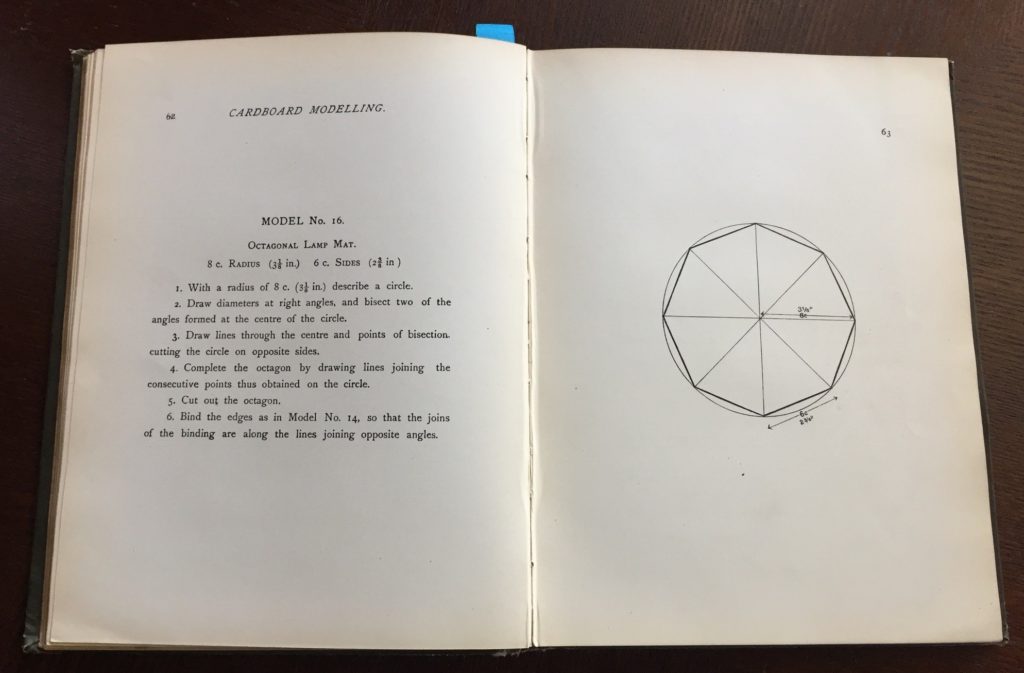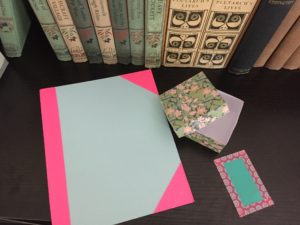Cardboard Sloyd
By R. A. Pennethorne
L’Umile Pianta, April, 1906
Editor’s Note: Since first learning about it three years ago, the principles of sloyd have resonated with me. This particular article took my understanding to a new level and sent me on a quest to learn more about cardboard sloyd and its importance in a Charlotte Mason education. I hope you will be as intrigued as I have been. I mention the article in an interview with A Delectable Education and I will share more of my sloyd research in upcoming articles. -Brittney
Miss Mason always says she believes Sloyd to be the most valuable and most educative of all the handicrafts. If this be the case, why are its advantages not used, so that the subject may have its fullest educational value?
The advantages (theoretically) of teaching Sloyd are:
- It trains the eye to accuracy (accuracy being understood as absolute, not relative) in (a) drawing a straight line, (b) measuring distances and angles, (c) cutting on the line drawn.
- It trains the hand to follow the guidance of the eye, and to obey exactly the impulse of the motor nerves transmitting the message of what the hand is required to do.
- It strengthens the muscles of the hand by exercise.
II. MENTAL
- It increases the child’s power of reasoning by giving exercise in working from diagrams or written directions.
- It exercises his imagination, in that when he is working from a diagram or directions, he must make a mental picture of the finished model, or he cannot work at it intelligently.
III. MORAL
It encourages the child in habits of diligence, neatness, order, and absolute truthfulness of work in every detail.
These are the advantages of Sloyd as set forth by theorists; but theory is of absolutely no value unless it is used to guide practical work. These advantages do not, or, at any rate, should not exist merely in the always fertile imagination of the theoretical educator. They were meant to, and must enter into, all our work in Sloyd.
To take these advantages separately:
It seems obvious to most people that Sloyd is of great use in eye-training, yet how few use it to the best advantage.
 It should train the eye to guide the hand in drawing a straight line, not in ruling one with a ruler and a more or less blunt pencil. Then the line must be straight, neither wobbly nor uneven in thickness. A line has length without breadth, therefore the pencil point must be as fine as possible; for if the line is to serve as a guide in cutting, and yet is made nearly a millimetre in width, how can we know what particular part of the line is the right part on which to cut? For, of course, the edge of the Sloyd knife, when well ground, is much finer than the finest pencil line. Most people will say that a straight line, accurately drawn without the help of a ruler, is an impossible goal at which to aim; but was it not Montaigne who said, “Why let a child depend on rulers, angles, or similar crutches, when he should learn from the first to depend only on himself?” I believe that if a child is properly taught from the very first, and is not allowed to use “crutches,” he can easily learn to draw quite straight lines without the use of a ruler.
It should train the eye to guide the hand in drawing a straight line, not in ruling one with a ruler and a more or less blunt pencil. Then the line must be straight, neither wobbly nor uneven in thickness. A line has length without breadth, therefore the pencil point must be as fine as possible; for if the line is to serve as a guide in cutting, and yet is made nearly a millimetre in width, how can we know what particular part of the line is the right part on which to cut? For, of course, the edge of the Sloyd knife, when well ground, is much finer than the finest pencil line. Most people will say that a straight line, accurately drawn without the help of a ruler, is an impossible goal at which to aim; but was it not Montaigne who said, “Why let a child depend on rulers, angles, or similar crutches, when he should learn from the first to depend only on himself?” I believe that if a child is properly taught from the very first, and is not allowed to use “crutches,” he can easily learn to draw quite straight lines without the use of a ruler.
 Why should he not be trained, too, to judge distances by the eye instead of measuring every inch? In this, as in everything else, of course practice makes perfect, and it seems as if there should be very little more difficulty for a child in learning to draw a straight line of exactly the length he requires (controlling his hand by will and eye alone), than there is in learning to form neatly and well the lines and curves of all the letters of the alphabet, which must present such enormous difficulty to a child until he has all the muscles of his hand well under control. In the case of children beginning Sloyd when they are older, say at twelve or more, they, being unaccustomed to drawing and measuring without help, must depend to a great extent on “crutches” in the actual drawing of the diagram, but let the “crutches” be used only for the diagram. The cutting must be guided by the line and eye alone, or Sloyd loses more than half its value.
Why should he not be trained, too, to judge distances by the eye instead of measuring every inch? In this, as in everything else, of course practice makes perfect, and it seems as if there should be very little more difficulty for a child in learning to draw a straight line of exactly the length he requires (controlling his hand by will and eye alone), than there is in learning to form neatly and well the lines and curves of all the letters of the alphabet, which must present such enormous difficulty to a child until he has all the muscles of his hand well under control. In the case of children beginning Sloyd when they are older, say at twelve or more, they, being unaccustomed to drawing and measuring without help, must depend to a great extent on “crutches” in the actual drawing of the diagram, but let the “crutches” be used only for the diagram. The cutting must be guided by the line and eye alone, or Sloyd loses more than half its value.
What advantage can possibly accrue to a child who, having ruled his line, lays a steel angle against it, and mechanically passes a Sloyd knife several times along the side of the angle till the knife has “arrived” through the cardboard?
He cannot exercise any will-power in guiding the knife, nor train his eye in following the line, and it is ten to one that the steel angle will slip a hairsbreadth (or probably considerably more), and so destroy the final accuracy of the model.
Again, if a steel angle is used to guide the knife, the child has double work to do, as it requires considerable strength to keep the angle from slipping, as well as that required to cut the cardboard.
 If thick cardboard be used, the actual cutting needs a considerable amount of strength. Therefore, if no angle is used, obviously the strength previously used for holding the angle in place, may now be better employed in the use of the knife, or reserved for a future occasion, and this will save the child much labour.
If thick cardboard be used, the actual cutting needs a considerable amount of strength. Therefore, if no angle is used, obviously the strength previously used for holding the angle in place, may now be better employed in the use of the knife, or reserved for a future occasion, and this will save the child much labour.
Some people think that it would be quite impossible for ordinary children to depend only on the line and their own eye in cutting, but this is not the case, as has been proved by teaching a large class of children in a school on these lines. No steel angles were used at all except by the older girls for their bookbinding, and all the Sloyd results were excellent, although some of the children were quite young.
Another great disadvantage of using a steel angle is that the knife is extremely liable to slip on to the angle, and from that on to the fingers holding it, sometimes causing rather serious cuts. If no angle is used, the child cuts slowly, thinking of the line he is keeping to, and there is very little danger of the knife slipping, if that and the cardboard are properly held.
Then with regard to diagram drawing, how is the child to get any mental benefit from Sloyd, if all the diagrams are worked out and explained so as to save the child any trouble or thought.
When first beginning Sloyd, by all means let the diagrams be drawn for the child on the blackboard, but not on the cardboard to be used for the model.
The diagram is to serve as a guide to the child, so that when first beginning Sloyd he may see the measurements and positions of the lines.
As soon as he shows sufficient intelligence and grasp of the principles of Sloyd, let him work out his own diagrams to scale, with very little or no help.
Children may very soon do simple diagrams quite without help, but will require a little help at first with more complicated diagrams.
Then as to exercising the muscles of the hand. Mechanical movement is not of half so much value in exercising and developing the muscles as movement controlled and localised by an effort of will.
 This fact is recognised in the teaching of Swedish drill by the best methods, in which the pupil is told which special muscles each exercise is intended to develop, and so he can concentrate his thought on those particular muscles, thus gaining the fullest possible benefit from the exercise.
This fact is recognised in the teaching of Swedish drill by the best methods, in which the pupil is told which special muscles each exercise is intended to develop, and so he can concentrate his thought on those particular muscles, thus gaining the fullest possible benefit from the exercise.
So in Sloyd; if the hand is made to move mechanically, guided by the steel angle, the muscles are not under the control of the will, and so do not receive the fullest possible benefit from the exercise.
The chief reason why so many people seem quite unable to draw, is that they have not the muscles of the hand sufficiently under control to obey the impulse of the will, or to follow the mental image they have made and wish to reproduce.
Sloyd should be a great help to drawing, as drawing is to Sloyd, in the control acquired over the muscles of the hand.
One very important point in teaching Sloyd is that every detail of the work must be absolutely true. Not a single crooked line, imperfectly joined corner, or inaccurate measurement may be allowed, and the inside work that is to be covered up must be just as neat as that which will be visible in the finished model.
Thus the child will learn the value and importance of beautiful and perfect work, and will bring this lesson that he has learnt into everything he does.
Sloyd also gives training in patience and perseverance in finishing carefully all the minute details of a model.
People will perhaps say that it is a pity to spend much time over one handicraft when there is so much to be learnt of more importance than Sloyd.
Other subjects may, perhaps, be of more importance from a purely utilitarian point of view, but surely that is not the only point from which we regard the subjects of the school curriculum?
We require of the subjects also that they shall give inspiring ideas, widen the horizon of thought, give new interests, and last, but not least, help the child to form new relations with things or materials outside himself.
Sloyd, I think, fulfils all these conditions to a great extent, and therefore has an important place as an instrument of education.
Editor’s Note: The formatting of the above article was optimized for online viewing. To access a version which is formatted more similarly to the original, and which includes the original page numbers, please click here.

5 Replies to “Cardboard Sloyd”
Wow! This makes the whole point of sloyd so much clearer. I honestly can’t imagine doing it without a ruler or straight edge but I can see how that the benefits are greatest by learning to do without. Now to figure out how to teach it this way!!
Kara, I’m so glad you enjoyed the article! Reading it inspired me to find out exactly how sloyd was taught so that we might enjoy these benefits too. I’ll be sharing my findings very soon in upcoming articles. I hope they will encourage you to give it a go!
I have heard that by cardboard, cardstock is meant to be used. Is this accurate?
Any progress on getting the book released?
Yes! It is available at this link.